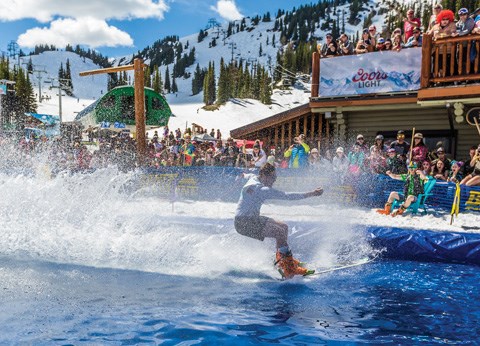BANFF – After lengthy negotiations, Parks Canada gave Sunshine an ultimatum to sign off on a new lease and controversial plan outlining future development at the resort, or risk losing the right to operate the Banff National Park business.
The ski resort, which has been operating without a long-range plan for two decades, met the federal agency’s Jan. 21 deadline to confirm whether it was prepared to accept a new 42-year lease and accompanying site guidelines.
In his agreement letter on Jan. 21, Sunshine president and CEO Ralph Scurfield said the ski resort still has “grave concerns” about the process and its outcome, particularly over parking problems at the resort.
“Despite our disappointment, and concerns which will be communicated separately, we accept the site guidelines as you have presented them,” wrote Scurfield.
“The alternative is to lose our family business since 1981 and my life’s work for the last 38 years.”
In the 1990s, widespread concerns over rampant development in Banff National Park, and findings of the $2 million Banff-Bow Valley study that the park was suffering ecologically, led Parks Canada to begin setting limits on commercial growth.
All commercial developers in the mountain parks, including townsites, outlying commercial accommodations and ski areas, have concluded negotiations with Parks Canada to come up with permanent caps on new development and guidelines on the type of development allowed - except Sunshine.
The ski hill has been operating without a long-range plan for 20 years.
Parks Canada approved the site guidelines on Dec. 17, 2018, but Parks Canada CEO Michael Nadler played hardball.
He gave Sunshine Village 35 days to decide whether or not they wanted to enter into a new lease for the ski resort with the new site guidelines or risk putting the operation of the ski resort out to public tender. The deadline was Jan. 21.
In his letter to Scurfield, Nadler said that if Sunshine does not provide “unconditional confirmation” that it’s prepared to conclude and execute a new lease with the site guidelines, “the agency will understand that to mean you do not wish to enter into the initialed lease with the site guidelines appended and proceed to seek a new operator through a public request for proposals.”
The site guidelines have not been publicly released by Parks Canada, but have been posted by Sunshine Village on its website. Some of the bigger aspects of the guidelines were also presented by Nadler in his letter to Scurfield.
Although there are conditions, the final guidelines approved by the federal agency allow for up to 8,500 skiers at one time from the current 6,500, an additional 3,650 square metres of commercial space, eight new lifts and up to 80 hectares of new ski terrain.
Development of new lifts and runs outside the current developed area in the Hayes Hill and Meadow Park areas is allowed, as are improvements to Angel Ski Way and development of surface water reservoirs.
In return, 61 hectares are being removed from the resort because Parks Canada considers them to have “high ecological value.” Lands include some on either side of the parking lot considered a wildlife corridor, Lower Bye Bye Bowl and Eagle Crest.
Parks Canada rejected Sunshine’s parking proposals, which included a 280-stall parkade at the existing lot at the base of the resort in combination with a 730-stall satellite lot on land along the access road, about six kilometres from the resort.
Scurfield, in his Jan. 21 letter to Parks Canada, said the parking solutions presented by the ski resort were rejected without explanation.
“We are disappointed by how the decision may negatively affect our operations and the visitor experience in the future,” he wrote.
A lack of parking, particularly on the peak days and busy holidays, has been one of the more controversial issues between Sunshine and Parks Canada over the years, and has involved several court cases.
When the existing 1,700-stall surface lot is full, skiers park their vehicles along the lower section of the access road and in two parking lots at the bottom of the access road. Parking is banned on the upper section of the road because of avalanche paths.
The new site guidelines provide for transportation and parking through a combination of transit, incentive programs and/or a parking structure of no pre-determined size.
“Research indicates that the creation of more parking in response to increasing demand is often a short-term solution, as any increased capacity incentivizes even more people to use their personal vehicles,” according to the approved guidelines.
Sunshine Village could not be reached for comment by press time, but referred the Outlook to its website.
Parks Canada released a statement to the Outlook, noting it’s committed to downhill skiing in the national parks.
“The Sunshine Village Ski area site guidelines will provide long-term predictability for the operator, while ensuring that ecological integrity including the protection of wildlife is the first priority for decision making, that the ski area is a viable business and visitors can have high quality experiences at the ski area for many years to come,” according to the statement.




